人教版(PEP)小学英语六年级上册重点知识整理
文档属性
| 名称 | 人教版(PEP)小学英语六年级上册重点知识整理 | 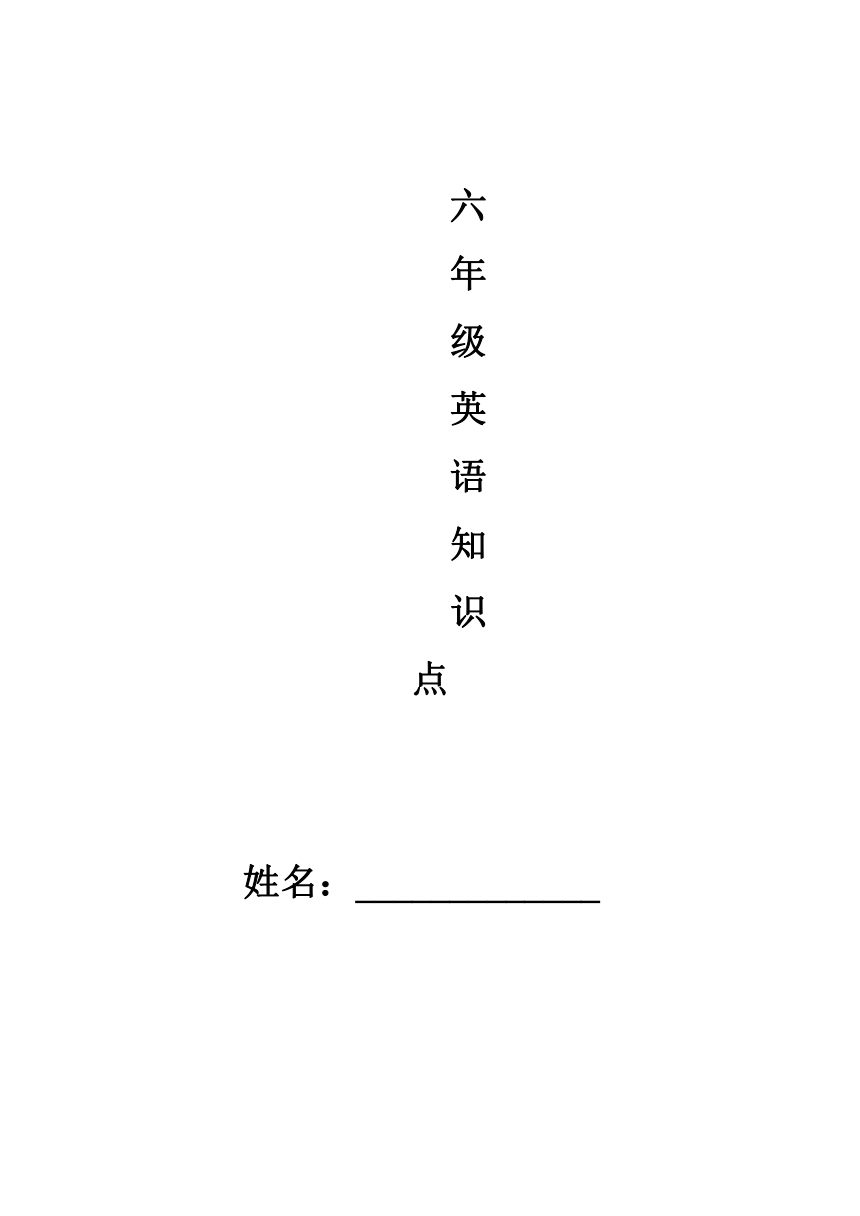 | |
| 格式 | zip | ||
| 文件大小 | 33.5KB | ||
| 资源类型 | 教案 | ||
| 版本资源 | 人教版(PEP) | ||
| 科目 | 英语 | ||
| 更新时间 | 2016-09-01 08:52:49 | ||
图片预览

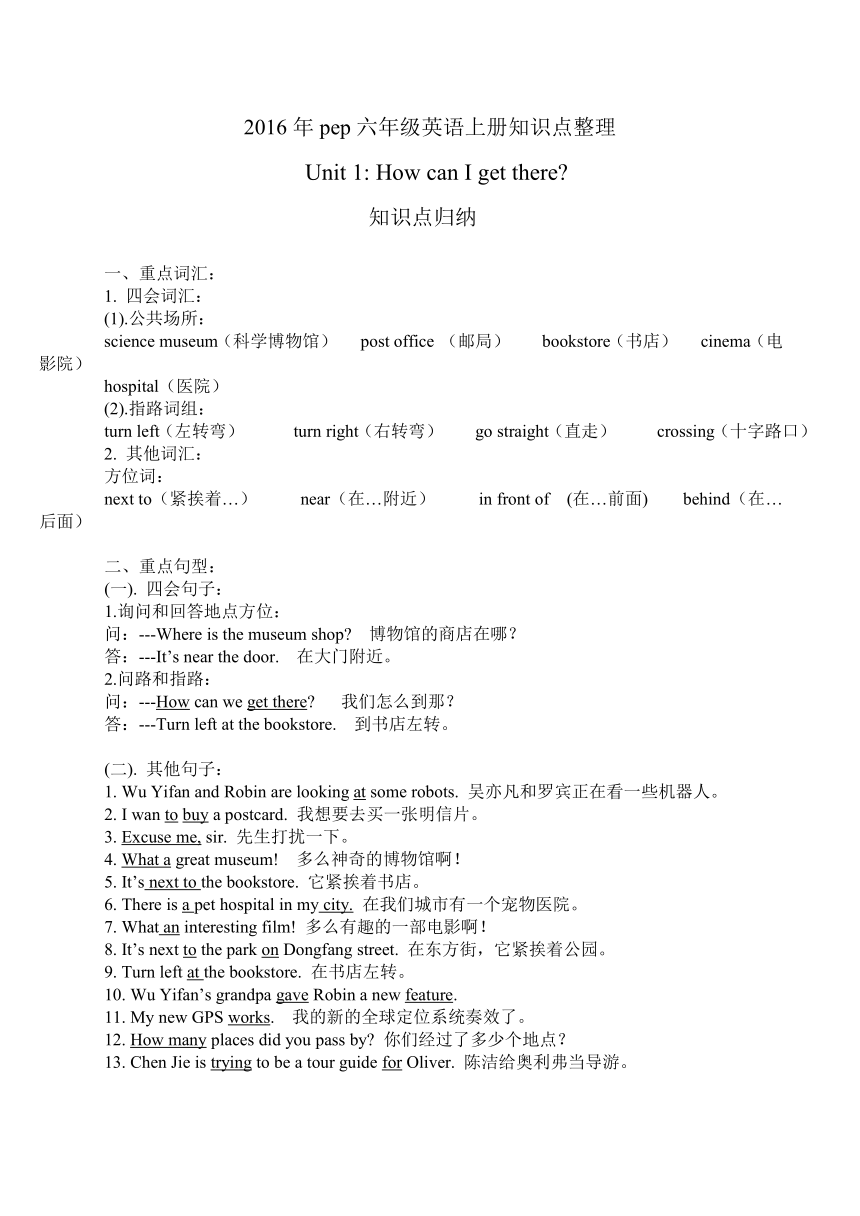
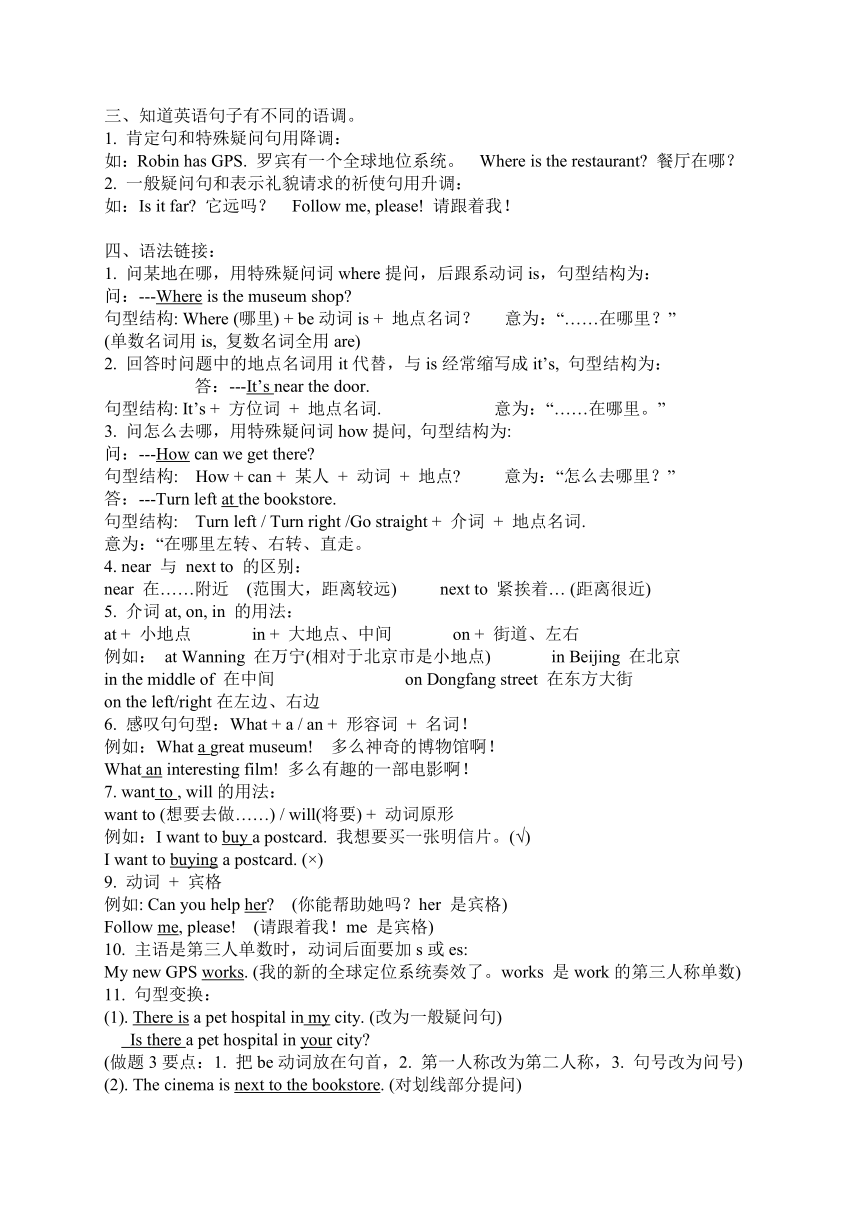
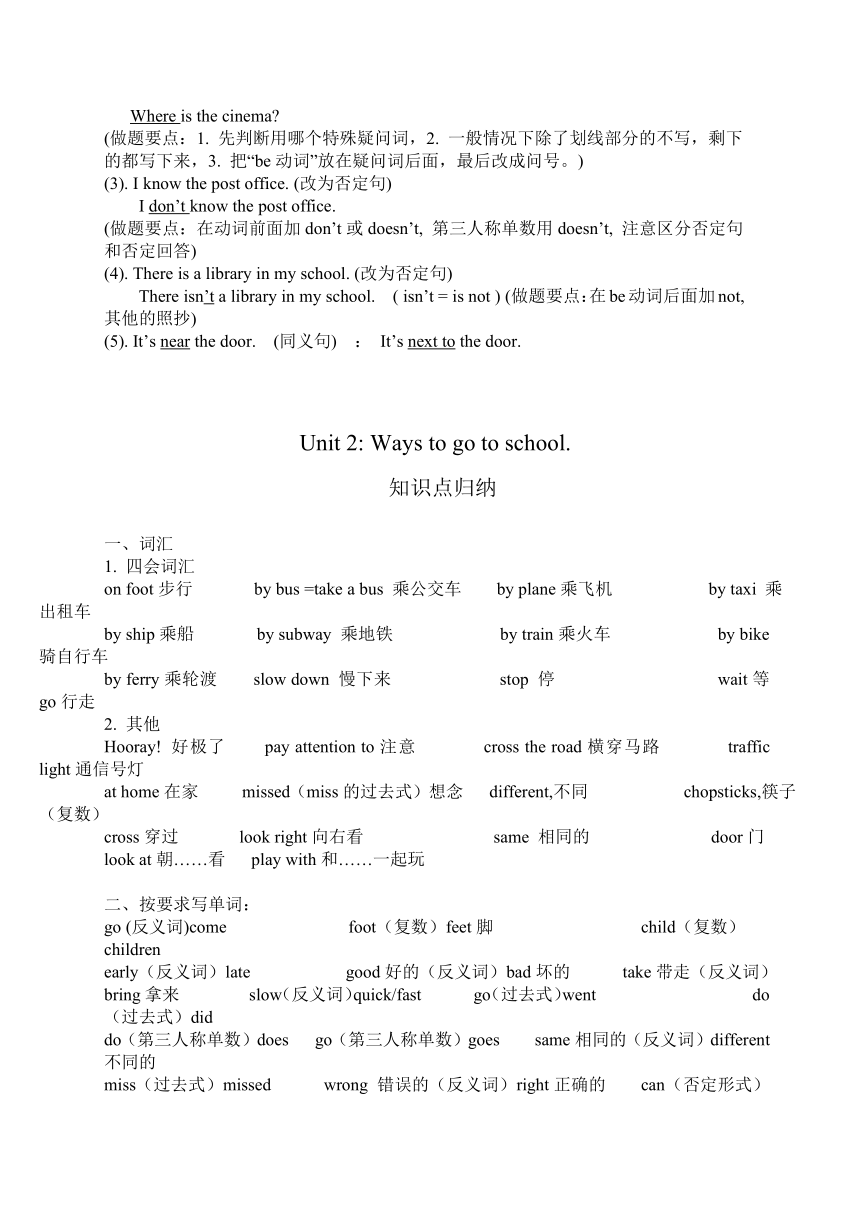
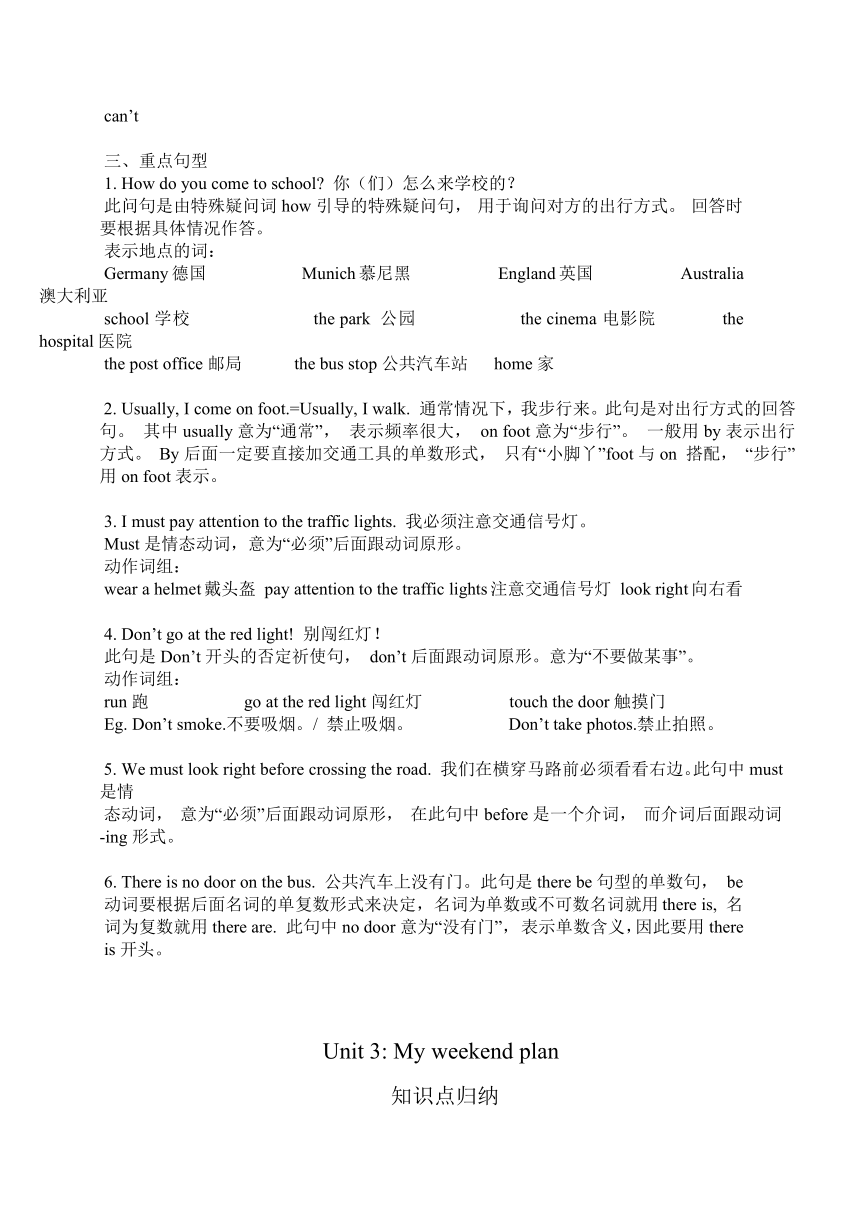
文档简介
六
年
级
英
语
知
识
点
姓名:_____________
2016年pep六年级英语上册知识点整理
Unit
1:
How
can
I
get
there
知识点归纳
一、重点词汇:
1.
四会词汇:
(1).公共场所:
science
museum(科学博物馆)
post
office
(邮局)
bookstore(书店)
cinema(电影院)
hospital(医院)
(2).指路词组:
turn
left(左转弯)
turn
right(右转弯)
go
straight(直走)
crossing(十字路口)
2.
其他词汇:
方位词:
next
to(紧挨着…)
near(在…附近)
in
front
of
(在…前面)
behind(在…后面)
二、重点句型:
(一).
四会句子:
1.询问和回答地点方位:
问:---Where
is
the
museum
shop
博物馆的商店在哪?
答:---It’s
near
the
door.
在大门附近。
2.问路和指路:
问:---How
can
we
get
there
我们怎么到那?
答:---Turn
left
at
the
bookstore.
到书店左转。
(二).
其他句子:
1.
Wu
Yifan
and
Robin
are
looking
at
some
robots.
吴亦凡和罗宾正在看一些机器人。
2.
I
wan
to
buy
a
postcard.
我想要去买一张明信片。
3.
Excuse
me,
sir.
先生打扰一下。
4.
What
a
great
museum!
多么神奇的博物馆啊!
5.
It’s
next
to
the
bookstore.
它紧挨着书店。
6.
There
is
a
pet
hospital
in
my
city.
在我们城市有一个宠物医院。
7.
What
an
interesting
film!
多么有趣的一部电影啊!
8.
It’s
next
to
the
park
on
Dongfang
street.
在东方街,它紧挨着公园。
9.
Turn
left
at
the
bookstore.
在书店左转。
10.
Wu
Yifan’s
grandpa
gave
Robin
a
new
feature.
11.
My
new
GPS
works.
我的新的全球定位系统奏效了。
12.
How
many
places
did
you
pass
by
你们经过了多少个地点?
13.
Chen
Jie
is
trying
to
be
a
tour
guide
for
Oliver.
陈洁给奥利弗当导游。
三、知道英语句子有不同的语调。
1.
肯定句和特殊疑问句用降调:
如:Robin
has
GPS.
罗宾有一个全球地位系统。
Where
is
the
restaurant
餐厅在哪?
2.
一般疑问句和表示礼貌请求的祈使句用升调:
如:Is
it
far
它远吗?
Follow
me,
please!
请跟着我!
四、语法链接:
1.
问某地在哪,用特殊疑问词where提问,后跟系动词is,句型结构为:
问:---Where
is
the
museum
shop
句型结构:
Where
(哪里)
+
be动词is
+
地点名词?
意为:“……在哪里?”
(单数名词用is,
复数名词全用are)
2.
回答时问题中的地点名词用it代替,与is经常缩写成it’s,
句型结构为:
答:---It’s
near
the
door.
句型结构:
It’s
+
方位词
+
地点名词.
意为:“……在哪里。”
3.
问怎么去哪,用特殊疑问词how提问,
句型结构为:
问:---How
can
we
get
there
句型结构:
How
+
can
+
某人
+
动词
+
地点
意为:“怎么去哪里?”
答:---Turn
left
at
the
bookstore.
句型结构:
Turn
left
/
Turn
right
/Go
straight
+
介词
+
地点名词.
意为:“在哪里左转、右转、直走。
4.
near
与
next
to
的区别:
near
在……附近
(范围大,距离较远)
next
to
紧挨着…
(距离很近)
5.
介词at,
on,
in
的用法:
at
+
小地点
in
+
大地点、中间
on
+
街道、左右
例如:
at
Wanning
在万宁(相对于北京市是小地点)
in
Beijing
在北京
in
the
middle
of
在中间
on
Dongfang
street
在东方大街
on
the
left/right在左边、右边
6.
感叹句句型:What
+
a
/
an
+
形容词
+
名词!
例如:What
a
great
museum!
多么神奇的博物馆啊!
What
an
interesting
film!
多么有趣的一部电影啊!
7.
want
to
,
will的用法:
want
to
(想要去做……)
/
will(将要)
+
动词原形
例如:I
want
to
buy
a
postcard.
我想要买一张明信片。(√)
I
want
to
buying
a
postcard.
(×)
9.
动词
+
宾格
例如:
Can
you
help
her
(你能帮助她吗?her
是宾格)
Follow
me,
please!
(请跟着我!me
是宾格)
10.
主语是第三人单数时,动词后面要加s或es:
My
new
GPS
works.
(我的新的全球定位系统奏效了。works
是work的第三人称单数)
11.
句型变换:
(1).
There
is
a
pet
hospital
in
my
city.
(改为一般疑问句)
Is
there
a
pet
hospital
in
your
city
(做题3要点:1.
把be动词放在句首,2.
第一人称改为第二人称,3.
句号改为问号)
(2).
The
cinema
is
next
to
the
bookstore.
(对划线部分提问)
Where
is
the
cinema
(做题要点:1.
先判断用哪个特殊疑问词,2.
一般情况下除了划线部分的不写,剩下的都写下来,3.
把“be动词”放在疑问词后面,最后改成问号。)
(3).
I
know
the
post
office.
(改为否定句)
I
don’t
know
the
post
office.
(做题要点:在动词前面加don’t或doesn’t,
第三人称单数用doesn’t,
注意区分否定句和否定回答)
(4).
There
is
a
library
in
my
school.
(改为否定句)
There
isn’t
a
library
in
my
school.
(
isn’t
=
is
not
)
(做题要点:在be动词后面加not,
其他的照抄)
(5).
It’s
near
the
door.
(同义句)
:
It’s
next
to
the
door.
Unit
2:
Ways
to
go
to
school.
知识点归纳
一、词汇
1.
四会词汇
on
foot步行
by
bus
=take
a
bus
乘公交车
by
plane乘飞机
by
taxi
乘出租车
by
ship乘船
by
subway
乘地铁
by
train乘火车
by
bike骑自行车
by
ferry乘轮渡
slow
down
慢下来
stop
停
wait等
go行走
2.
其他
Hooray!
好极了
pay
attention
to注意
cross
the
road横穿马路
traffic
light通信号灯
at
home在家
missed(miss的过去式)想念
different,不同
chopsticks,筷子(复数)
cross穿过
look
right向右看
same
相同的
door门
look
at朝……看
play
with和……一起玩
二、按要求写单词:
go
(反义词)come
foot(复数)feet脚
child(复数)children
early(反义词)late
good好的(反义词)bad坏的
take带走(反义词)bring拿来
slow(反义词)quick/fast
go(过去式)went
do(过去式)did
do(第三人称单数)does
go(第三人称单数)goes
same相同的(反义词)different不同的
miss(过去式)missed
wrong
错误的(反义词)right正确的
can(否定形式)can’t
三、重点句型
1.
How
do
you
come
to
school
你(们)怎么来学校的?
此问句是由特殊疑问词how引导的特殊疑问句,
用于询问对方的出行方式。
回答时要根据具体情况作答。
表示地点的词:
Germany德国
Munich慕尼黑
England英国
Australia澳大利亚
school学校
the
park
公园
the
cinema电影院
the
hospital医院
the
post
office邮局
the
bus
stop公共汽车站
home家
2.
Usually,
I
come
on
foot.=Usually,
I
walk.
通常情况下,我步行来。此句是对出行方式的回答句。
其中usually意为“通常”,
表示频率很大,
on
foot意为“步行”。
一般用by表示出行方式。
By后面一定要直接加交通工具的单数形式,
只有“小脚丫”foot与on
搭配,
“步行”用on
foot表示。
3.
I
must
pay
attention
to
the
traffic
lights.
我必须注意交通信号灯。
Must是情态动词,意为“必须”后面跟动词原形。
动作词组:
wear
a
helmet戴头盔
pay
attention
to
the
traffic
lights注意交通信号灯
look
right向右看
4.
Don’t
go
at
the
red
light!
别闯红灯!
此句是Don’t开头的否定祈使句,
don’t后面跟动词原形。意为“不要做某事”。
动作词组:
run跑
go
at
the
red
light闯红灯
touch
the
door触摸门
Eg.
Don’t
smoke.不要吸烟。/
禁止吸烟。
Don’t
take
photos.禁止拍照。
5.
We
must
look
right
before
crossing
the
road.
我们在横穿马路前必须看看右边。此句中must是情
态动词,
意为“必须”后面跟动词原形,
在此句中before是一个介词,
而介词后面跟动词-ing形式。
6.
There
is
no
door
on
the
bus.
公共汽车上没有门。此句是there
be句型的单数句,
be动词要根据后面名词的单复数形式来决定,
名词为单数或不可数名词就用there
is,
名词为复数就用there
are.
此句中no
door意为“没有门”,
表示单数含义,因此要用there
is开头。
Unit
3:
My
weekend
plan
知识点归纳
一、重点单词和短语
1.
四会词汇:
visit拜访
visit
my
grandparents
拜访我的祖父母
film电影
see
a
film看电影
trip旅游
take
a
trip去旅游
supermarket
超市
go
to
the
supermarket
去超市
evening晚上,傍晚
tonight在今晚
tomorrow明天
next
week下周
dictionary字典
comic
滑稽的
comic
book连环画册
word
book单词本
postcard明信片
take
a
trip去旅游
2、其他
三会词汇:
learn学习
teach教
disturb打扰
without没有
pool池子
jump
in跳进
remember记住
lesson
课
space太空
travel(尤指长途)旅游
half一半
price
价格
moon月亮
make
a
snowman
堆雪人
lots
of=
a
lot
of
许多
share
sth(事
)with
sb(人)和某人分享某物
表示时间的单词:
evening晚上,傍晚
tonight在今晚
tomorrow明天
next
week下周
this
morning今天早晨
this
afternoon今天下午
this
evening
今天晚上
this
weekend
下周末
3、动词短语:
make
a
snowman
堆雪人
watch
TV看电视
learn
how
to
swim学怎样游泳
go
skating去滑冰
go
skiing去滑雪
row
a
boat划船
go
fishing
去钓鱼
go
shopping去购物
make
mooncakes
做月饼
read
a
poem读诗
4、表示地点的词:
school学校
park
公园
cinema电影院
hospital医院
post
office邮局
bus
stop公共汽车站
home家
supermarket超市
museum博物馆,
bookstore书店
restaurant餐馆
bank银行
lake湖
library图书馆
zoo动物园
park公园
garden花园
hotel旅馆
二、按要求写单词
look
for
(同义词)
find
leaf
(复数)
leaves
picture
(复数)
pictures
see
(同义词)
watch/look
film
(同义词)
movie
buy
(反义词)
sell(同音词)bye/by
am
/is
/are
(原形)
be
is
/am
(复数)are
this
(反义词)
that
going
(原形)
go
swim(现在进行时)swimming
can(否定形式)
can’t
too(同音词)
two
/to
clothe(复数)clothes
ice-skate(现在进行时)ice-skating
autumn(同义词)
fall
autumn(反义词)spring
teach
(反义词)
learn
三、重点句型分析
1.
---What
are
you
going
to
do
tomorrow
---I’m
going
to
have
an
art
lesson.
此句是个一般将来时态的特殊疑问句。
用了be
going
to
结构。“be
going
to
+动词原形”构成一般将来时态,
表示计划、安排将要做的事或根据目前推测将要发生的动作,意为“打算,将要”。
例如:
I’m
going
to
make
a
snowman.
我打算去堆雪
We’re
going
fishing.
我们打算去钓鱼。
2.
We
are
going
to
draw
some
pictures
in
Renmin
Park.
此句是be
going
to
结构的肯定句式。
基本结构为:
主语+
be
going
to
+动词原形+表示将来的时间。
some一些,用于肯定句中,
后接可数名词的复数形式或不可数名词,而在疑问句或否定中表示一些要用any。
3.
---Where
are
you
going
---We’re
going
to
the
cinema.
此句是where
引导的一般将来时态的特殊疑问句,
where意为“哪里”,
它是对地点提问的特殊疑问词,
因此回答时要回答一个具体的地点。
4.
---When
are
you
going
---Next
Monday.
此句中when意为“什么时候,
何时”,
它引导的疑问句用来对年、月、日等时间进行提问。
如:---When
do
you
go
to
school
in
the
morning
---At
8:00.
5.
---How
can
you
learn
to
swim
without
going
to
a
pool
此句是由how
引导的特殊疑问句,
询问别人做事的方式、方法。
句中的can
意为“能够”,
是情态动词,后面跟动词原形。
“learn
to
do
something,”学习做某件事,
一般表示还没学或还没做的事情,含义将来的意思。
Unit
4:
I
have
a
pen
pal.
知识点归纳
一.重点词汇
dance
(dancing)
跳舞
sing
(singing
)
唱歌
hobby
play
football
(playing
football)
踢足球
(爱好)
read
a
story
(reading
stories
)
看/讲故事
do
kung
fu
(doting
kung
fu
)
练武术
live
(lives)
居住,住
like
(likes)
喜欢
teach
(teaches)
教
study
(
studies
Chinese
学习汉语)
第三人单数
go
(goes)
去
goes
hiking
去远足
read
(reads)
读
cook
(cooks
Chinese
food
制作中国食物)
do
(does)
does
word
puzzles
猜字谜
二.按要求写单词
1.
名词单数形式变复数形式:
hobby
→
hobbies
story
→
stories
puzzle
→
puzzles
2.
动词原形变为动词的第三人称单数:
不规则变化:have
→
has
规则变化:
一般情况下:
like
→
likes
read
→
reads
live
→
lives
sing
→
sings
sleep
→
sleeps
dance
→dances
cook
→
cooks
make
→
makes
love
→
loves
以o结尾:
do
→
does
go
→
goes
以辅音+y结尾,把y变为i加es:
study
→
studies
以ch结尾:
teach
→
teaches
watch
→
watches
3.
否定形式:
does
→
doesn’t
do
→
don’t
can
→
can’t
4.
动词-ing形式(现在分词):
单词末尾直接加ing:
talk
→
talking
do
→
doing
sing
→
singing
go
→
going
listen
→
listening
teach
→
teaching
play
→
playing
learn→
learning
fly
→
flying
把不发音的e去掉,再加ing:
dance
→
dancing
write
→
writing
hike
→
hiking
“辅+元+辅”,双写最后一个字母再加ing:
swim
→
swimming
run
→
running(奔跑)
shop
→
shopping
其他:he
(
所有格形式)
his
also(同义词)too
different(反义词)same
pen
pal笔友
三.重点句型:
1.
询问某人的爱好
---What
are
Peter’s
hobbies
彼特有什么爱好?
---He
likes
reading
stories.
他喜欢读故事。
2.
Does引导的一般疑问句:
---Does
he
live
in
Sydney
他住在悉尼吗?---No,
he
doesn’t.
不,他没有。
---Does
he
like
doing
word
puzzles
and
going
hiking
他喜欢猜字谜和远足吗?
---Yes,
he
does.
是的,他喜欢。
四.重点语法:
1.
问:What
are
sb’s(某人)
hobbies
某人的爱好是什么?(询问某人的爱好)
答:主语
+
like
/
likes
+动词-ing形式(+其他)。
例如:---What
are
Peter’s
hobbies
---He
likes
reading
stories.
(此处是对别人的爱好提问
( http: / / www.21cnjy.com"
\o
"欢迎登陆21世纪教育网 )及回答的句型,答句是一般现在时态的三单人称的句型。
当主语是第三人称单数时,
后面的动词要用它的第三人称单数形式,
同时like意为“喜欢”,
而喜欢做某事结构:like
+
v-ing
即like
后面跟动词的-ing形式。)
2.
---Does
he
live
in
Sydney
---No,
he
doesn’t.
此句是助动词does开头的一般
( http: / / www.21cnjy.com"
\o
"欢迎登陆21世纪教育网 )疑问句。
其回答要根据助动词和主语来决定。
结构为“Does+
三单人称(he/she
/某人名字)+
动词原形?”
肯定回答结构:
Yes,
主语+
does.
否定回答结构:
No,
主语+
doesn’t..
总结:由助动词
Do
/
Does引导的一般疑问句:
---Do
you
/
they
/
we
live
in
Sydney
---Yes,
I
/
they
/
we
do.
No,
I
/
they
/
we
don’t.
---Does
he
/
she
/
某人名字live
in
Sydney
O
---Yes,
he
/
she
does.
No,
he
/
she
doesn’t.
---Does
he
/
she
/
某人名字like
doing
word
puzzles
and
going
hiking
---Yes,
he
/
she
does.
No,
he
/
she
doesn’t.
注意:助动词Do
/
Does引出的问句中一定有一个实义动词,为动词原形。助动词一出现,后面动词就要用动词原形。
五.其他句子:
1.
He
lives
on
a
farm,
so
sometimes
he
reads
to
the
cows.
他住在农场里,所以有时他对牛讲故事。
2.
He
also
likes
singing.
他也喜欢唱歌。
3.
I
like
reading
st
( http: / / www.21cnjy.com"
\o
"欢迎登陆21世纪教育网 )ories.
I
also
like
singing
and
doing
kung
fu.
我喜欢读书,我还喜欢唱歌和练功夫。4.
Does
he
live
in
China,
too
他也住在中国吗?
5.
No,
he
doesn’t.
He
lives
in
Australia,
but
he
studies
Chinese.
不,他住在澳大利亚,但他在学习中文。
6.
I’m
going
to
teach
him
the
Chinese
song”
Jasmine
Flower”.
我打算教他一首<<茉莉花>>的中文歌曲。
7.
I’m
writing
an
email
to
my
new
pen
pal
in
Australia.
我正给澳大利亚的新笔友写一封电子邮件。
8.
Can
I
also
be
his
pen
pal
Sure.
Why
not
我也能成为他的新笔友吗
当然。为什么不能呢?
9.
Do
you
want
to
learn
about
robots
你想要学习关于机器人的事吗?
10.
He
teaches
students
to
make
robots.
他教学生去制作机器人。
11.
Who
does
the
dishes
谁洗碗?
Who
teaches
math
谁教数学?
Who
cooks
noodles
谁煮面?
12.
There
is
a
dancing
class
on
Sunday
at
1
p.m..
星期日下午一点有一节舞蹈课。
13.
I
like
dancing,
and
I
need
a
partner.
我喜欢跳舞,我需要一个舞伴。
14.
What
do
you
do
on
Sundays
周日你做什么?
15.
Join
our
football
club!
加入我们的足球俱乐部吧!
Unit
5:
What
does
he
do
知识点归纳
一.重点单词和短语
1.
四会词汇
factory工厂
worker工人
postman邮递员
businessman商人(企业家)
police
officer警察
fisherman渔民
scientist科学家
pilot飞行员
coach教练
job工作
2.
三会词汇
teacher教师
student学生
doctor医生
nurse护士
singer歌手
dancer舞者
cleaner清洁工
writer作家
taxi
driver的士司机
farmer农民
think
of考虑/有……想法
go
to
work去工作
university大学
study
hard努力学习
stay
healthy保持健康
healthy
life健康生活
go
home
回家
lots
of许多
go
to
the
camp去度假营
be
good
at擅长……
head
teacher校长
3.
表示职业的词:
worker工人
postman邮递员
businessman商人
coach教练
police
officer警察
fisherman渔民
scientist,科学家
pilot飞行员
tamer驯服手
farmer农民
assistant助手接待员
teacher老师
cleaner清洁工
doctor医生nurse护士
dentist牙医
tailor裁缝
salespersons售货员
pianist钢琴家
4.
表示地点的介词短语:
at
a
university
在一所大学
in
a
gym在一个体育馆
at
sea
在海上
on
a
boat在船上
at
the
zoo在动物园
in
a
school
在一所学校
in
a
car
company在一家汽车公司
in
a
bank在一家银行
5.
表示交通方式的词:
by
the
No.15
bus乘15路公交车
on
foot步行
by
bus
乘公交车
by
plane,乘飞机
by
taxi
乘出租车
by
ship乘船
by
subway
乘地铁
by
train乘火车
by
bike骑自行车
by
ferry乘轮渡
二、按要求写词语
do(三单)
does
work(三单)
works
he(主格)his(所有格)him(宾格)
she(主格)her(宾格或所有格)
business(名词)businessman(单数)
businessmen(复数)
fish(名词)fisher
can
(否定形式)can’t
drive
(名词)driver
teach
(名词)teacher
country(复数)countries
clean(名词)cleaner
write
(名词)writer
sing(名词)singer
dancer
(动词)dance
player(动词)
play
worker(动词)
work
is(否定形式)
isn’t
go(现在分词)going
see(三单)
sees
big
(反义词)small
tall
(反义词)short
thin(反义词)
fat/strong
short
(反义词)tall/long
sea(同音词)
see
lots
of
=a
lot
of
has
(原形)have
healthy(名词)health
life(动词)live
hard(反义词)easy
stay(三单)
stays
study
(三单)studies
science(名词)scientist
university(复数)universities
those(反义词)these
different
(反义词)same
like(三单)
likes
go(三单)
goes
want(三单)
wants
run(现在分词)running
report
(名词)reporter
use(现在分词)using
quick(副词)quickly
they(主格)them(宾格)their(形容词物主代词)
children(单数)child
didn’t
(否定形式)don’t
/doesn’t
unusual(反义词)usual
dangerous
(反义词)safe
farm(名词)
farmer
test(名词)
tester
eat(现在分词)eating
have(三单)
has
三、重点句型分析
1.
What
does
he
do
He’s
a
businessman.
这是一个询问职业的句型,
它的构成是
问:
What
do/
does+某(些)人+do ,
答:某人+
be+
a/an+职业名词
例如:---What
do
you
do
---I
am
a
doctor.
询问职业还有一个句型是“
What
+
be+某人?”。
例如:上面的句子还可以说“
What
is
he
”。
2.
---Where
does
he
work
---He
works
at
sea.
当你想询问他人在哪儿工作时,
用“
Where
do
/
does+
某(些)人+
work ”这个句型。
我们通常用一个表示地点的介宾短语来回答这个句型。
介宾短语是由介词加上名词或代词构成的。
3.
---How
does
he
go
to
work
---He
goes
to
work
by
bike.
要询问别人的上班方式,
可以用“
How
do
/
does+人物+
go
to
work ”句式来询问,
回答时要用到”by+交通工具的单词“或者是on
foot。
4.
What
a
great
job!
此句是由“what”引导的感叹句
( http: / / www.21cnjy.com"
\t
"_blank"
\o
"欢迎登陆21世纪教育网 ):“what”意为“多么”用作定语,修饰名词(被强调部分),单数可数名词前要加不定冠词
( http: / / www.21cnjy.com"
\t
"_blank"
\o
"欢迎登陆21世纪教育网 )a/an,复数可数名词或不可数名词
( http: / / www.21cnjy.com"
\t
"_blank"
\o
"欢迎登陆21世纪教育网 )前不用冠词
( http: / / www.21cnjy.com"
\t
"_blank"
\o
"欢迎登陆21世纪教育网 )。这类句子的结构形式是:
What+(a
/
an)+形容词+名词+主语+谓语+(it
is).
如:
What
a
clever
girl
she
is!
多么聪明的姑娘呀!
Unit
6:
How
do
you
feel
知识点归纳
一.
重点单词和短语
1.
个人感受:
angry生气的,
afraid害怕,
sad伤心的;难过的,
ill有病;不舒服
worried担心的;发愁的,
happy高兴的;
快乐的,
worry担心;担忧
2.
其他:
wear穿,
more,更多的,
deep深的,
breath呼吸,
count数数
chase追赶,
mice老鼠,
bad
邪恶的;坏的,
hurt(使)受伤
should应该,
feel觉得;感到,
sit坐,
grass草坪,
hear听见
ant蚂蚁,
stuck陷住;无法移动,
mud泥,
pull拉;拽,
everyone每人
wrong有毛病,
well健康;身体好
3.
情绪变化:
a
little
worried有一点点担心,
be
angry
with…生…的气,
be
afraid
of
…害怕…,
feel
angry/ill感觉生气/不舒服
4.
调节的方法:
see
a
doctor看医生,
take
a
deep
breath深呼吸
count
to
ten
数到十,
do
more
exercise做更多的运动
wear
warm
clothes穿暖和的衣服
5.
其他:
get
some
drinks拿一些饮料,
have
some
popcorn
吃一些爆米花
chase
the
mice追赶老鼠
二.
按要求写词语
first(基数词)one
mice(单数)mouse
these(反义词)those
these(单数)this
sad(反义词)happy
here反义词
there
can’t(肯定形式)can
can’t(完全形式)can
not
don’t(完全形式)
do
not
shouldn’t
(完全形式)should
not
won’t
(完全形式)
will
not
wrong(反义词)right
feel(三单)feels
angry
(反义词)happy
wear
(同音词)where
bad
(反义词)
good/well
hear(同音词)here
三.重点句型:
表达害怕的句型:
…be
afraid
of…
结构:主语(I
,They
,He…)+be动词+afraid
of+其他
注意:句型中的be动词要随主语人称和数的变化而变化。
如:I
am
afraid
of
the
black
dog.我害怕那只大黑狗。
They
are
afraid
of
him.它们害怕它。
He
is
afraid
of
the
mice.他害怕老鼠。
2.
表达生气的句型:
…be
angry
with…
结构:主语(I
,They,
He…)+be动词+angry
with+其他
注意:句型中的be动词要随主语人称和数的变化而变化。
如:The
cat
is
angry
with
them.这只猫很生它们的气。
I
am
angry
with
her.我很生她的气。
They
are
angry
with
the
bad
boy.
他们很生这个坏小子的气。
询问他人感觉怎么样的句型:
问句结构:How
+
do/does+主语+feel
答语结构:主语+be动词+描述心情状态的形容词
如:How
do
you
feel 你感觉怎么样?
I
am
happy.我高兴。
How
does
he
feel
他感觉怎么样?
He
is
angry.他生气。
用should来提建议……
结构:主语+should+动词原形+其他
如:He
should
see
a
doctor.他应该去看病。
You
should
have
a
try.你应该试一试。
注意:其否定形式是在should后直接加not,缩写为shouldn’t
如:We
shouldn’t
drink
and
drive.我们不应该酒后驾车。
询问某人正在做什么的句型:
问句结构:What
+
be动词+主语+doing
答语结构:主语+be动词+动词-ing形式+其他.
如:Zoom,
what
are
you
doing
here 祖姆,你在这儿做什么呢?
I
am
making
popcorn.我正在做爆米花。
四.其他句子
What’s
wrong
=
What’s
the
matter
=
What’s
the
problem
=
What’s
up
怎么了?
Let’s
have
some
popcorn.让我们吃一些爆米花吧。
Here
you
are.给你。
Wait
for
me.等我一下。
We
should
share!
我们应该分享!
年
级
英
语
知
识
点
姓名:_____________
2016年pep六年级英语上册知识点整理
Unit
1:
How
can
I
get
there
知识点归纳
一、重点词汇:
1.
四会词汇:
(1).公共场所:
science
museum(科学博物馆)
post
office
(邮局)
bookstore(书店)
cinema(电影院)
hospital(医院)
(2).指路词组:
turn
left(左转弯)
turn
right(右转弯)
go
straight(直走)
crossing(十字路口)
2.
其他词汇:
方位词:
next
to(紧挨着…)
near(在…附近)
in
front
of
(在…前面)
behind(在…后面)
二、重点句型:
(一).
四会句子:
1.询问和回答地点方位:
问:---Where
is
the
museum
shop
博物馆的商店在哪?
答:---It’s
near
the
door.
在大门附近。
2.问路和指路:
问:---How
can
we
get
there
我们怎么到那?
答:---Turn
left
at
the
bookstore.
到书店左转。
(二).
其他句子:
1.
Wu
Yifan
and
Robin
are
looking
at
some
robots.
吴亦凡和罗宾正在看一些机器人。
2.
I
wan
to
buy
a
postcard.
我想要去买一张明信片。
3.
Excuse
me,
sir.
先生打扰一下。
4.
What
a
great
museum!
多么神奇的博物馆啊!
5.
It’s
next
to
the
bookstore.
它紧挨着书店。
6.
There
is
a
pet
hospital
in
my
city.
在我们城市有一个宠物医院。
7.
What
an
interesting
film!
多么有趣的一部电影啊!
8.
It’s
next
to
the
park
on
Dongfang
street.
在东方街,它紧挨着公园。
9.
Turn
left
at
the
bookstore.
在书店左转。
10.
Wu
Yifan’s
grandpa
gave
Robin
a
new
feature.
11.
My
new
GPS
works.
我的新的全球定位系统奏效了。
12.
How
many
places
did
you
pass
by
你们经过了多少个地点?
13.
Chen
Jie
is
trying
to
be
a
tour
guide
for
Oliver.
陈洁给奥利弗当导游。
三、知道英语句子有不同的语调。
1.
肯定句和特殊疑问句用降调:
如:Robin
has
GPS.
罗宾有一个全球地位系统。
Where
is
the
restaurant
餐厅在哪?
2.
一般疑问句和表示礼貌请求的祈使句用升调:
如:Is
it
far
它远吗?
Follow
me,
please!
请跟着我!
四、语法链接:
1.
问某地在哪,用特殊疑问词where提问,后跟系动词is,句型结构为:
问:---Where
is
the
museum
shop
句型结构:
Where
(哪里)
+
be动词is
+
地点名词?
意为:“……在哪里?”
(单数名词用is,
复数名词全用are)
2.
回答时问题中的地点名词用it代替,与is经常缩写成it’s,
句型结构为:
答:---It’s
near
the
door.
句型结构:
It’s
+
方位词
+
地点名词.
意为:“……在哪里。”
3.
问怎么去哪,用特殊疑问词how提问,
句型结构为:
问:---How
can
we
get
there
句型结构:
How
+
can
+
某人
+
动词
+
地点
意为:“怎么去哪里?”
答:---Turn
left
at
the
bookstore.
句型结构:
Turn
left
/
Turn
right
/Go
straight
+
介词
+
地点名词.
意为:“在哪里左转、右转、直走。
4.
near
与
next
to
的区别:
near
在……附近
(范围大,距离较远)
next
to
紧挨着…
(距离很近)
5.
介词at,
on,
in
的用法:
at
+
小地点
in
+
大地点、中间
on
+
街道、左右
例如:
at
Wanning
在万宁(相对于北京市是小地点)
in
Beijing
在北京
in
the
middle
of
在中间
on
Dongfang
street
在东方大街
on
the
left/right在左边、右边
6.
感叹句句型:What
+
a
/
an
+
形容词
+
名词!
例如:What
a
great
museum!
多么神奇的博物馆啊!
What
an
interesting
film!
多么有趣的一部电影啊!
7.
want
to
,
will的用法:
want
to
(想要去做……)
/
will(将要)
+
动词原形
例如:I
want
to
buy
a
postcard.
我想要买一张明信片。(√)
I
want
to
buying
a
postcard.
(×)
9.
动词
+
宾格
例如:
Can
you
help
her
(你能帮助她吗?her
是宾格)
Follow
me,
please!
(请跟着我!me
是宾格)
10.
主语是第三人单数时,动词后面要加s或es:
My
new
GPS
works.
(我的新的全球定位系统奏效了。works
是work的第三人称单数)
11.
句型变换:
(1).
There
is
a
pet
hospital
in
my
city.
(改为一般疑问句)
Is
there
a
pet
hospital
in
your
city
(做题3要点:1.
把be动词放在句首,2.
第一人称改为第二人称,3.
句号改为问号)
(2).
The
cinema
is
next
to
the
bookstore.
(对划线部分提问)
Where
is
the
cinema
(做题要点:1.
先判断用哪个特殊疑问词,2.
一般情况下除了划线部分的不写,剩下的都写下来,3.
把“be动词”放在疑问词后面,最后改成问号。)
(3).
I
know
the
post
office.
(改为否定句)
I
don’t
know
the
post
office.
(做题要点:在动词前面加don’t或doesn’t,
第三人称单数用doesn’t,
注意区分否定句和否定回答)
(4).
There
is
a
library
in
my
school.
(改为否定句)
There
isn’t
a
library
in
my
school.
(
isn’t
=
is
not
)
(做题要点:在be动词后面加not,
其他的照抄)
(5).
It’s
near
the
door.
(同义句)
:
It’s
next
to
the
door.
Unit
2:
Ways
to
go
to
school.
知识点归纳
一、词汇
1.
四会词汇
on
foot步行
by
bus
=take
a
bus
乘公交车
by
plane乘飞机
by
taxi
乘出租车
by
ship乘船
by
subway
乘地铁
by
train乘火车
by
bike骑自行车
by
ferry乘轮渡
slow
down
慢下来
stop
停
wait等
go行走
2.
其他
Hooray!
好极了
pay
attention
to注意
cross
the
road横穿马路
traffic
light通信号灯
at
home在家
missed(miss的过去式)想念
different,不同
chopsticks,筷子(复数)
cross穿过
look
right向右看
same
相同的
door门
look
at朝……看
play
with和……一起玩
二、按要求写单词:
go
(反义词)come
foot(复数)feet脚
child(复数)children
early(反义词)late
good好的(反义词)bad坏的
take带走(反义词)bring拿来
slow(反义词)quick/fast
go(过去式)went
do(过去式)did
do(第三人称单数)does
go(第三人称单数)goes
same相同的(反义词)different不同的
miss(过去式)missed
wrong
错误的(反义词)right正确的
can(否定形式)can’t
三、重点句型
1.
How
do
you
come
to
school
你(们)怎么来学校的?
此问句是由特殊疑问词how引导的特殊疑问句,
用于询问对方的出行方式。
回答时要根据具体情况作答。
表示地点的词:
Germany德国
Munich慕尼黑
England英国
Australia澳大利亚
school学校
the
park
公园
the
cinema电影院
the
hospital医院
the
post
office邮局
the
bus
stop公共汽车站
home家
2.
Usually,
I
come
on
foot.=Usually,
I
walk.
通常情况下,我步行来。此句是对出行方式的回答句。
其中usually意为“通常”,
表示频率很大,
on
foot意为“步行”。
一般用by表示出行方式。
By后面一定要直接加交通工具的单数形式,
只有“小脚丫”foot与on
搭配,
“步行”用on
foot表示。
3.
I
must
pay
attention
to
the
traffic
lights.
我必须注意交通信号灯。
Must是情态动词,意为“必须”后面跟动词原形。
动作词组:
wear
a
helmet戴头盔
pay
attention
to
the
traffic
lights注意交通信号灯
look
right向右看
4.
Don’t
go
at
the
red
light!
别闯红灯!
此句是Don’t开头的否定祈使句,
don’t后面跟动词原形。意为“不要做某事”。
动作词组:
run跑
go
at
the
red
light闯红灯
touch
the
door触摸门
Eg.
Don’t
smoke.不要吸烟。/
禁止吸烟。
Don’t
take
photos.禁止拍照。
5.
We
must
look
right
before
crossing
the
road.
我们在横穿马路前必须看看右边。此句中must是情
态动词,
意为“必须”后面跟动词原形,
在此句中before是一个介词,
而介词后面跟动词-ing形式。
6.
There
is
no
door
on
the
bus.
公共汽车上没有门。此句是there
be句型的单数句,
be动词要根据后面名词的单复数形式来决定,
名词为单数或不可数名词就用there
is,
名词为复数就用there
are.
此句中no
door意为“没有门”,
表示单数含义,因此要用there
is开头。
Unit
3:
My
weekend
plan
知识点归纳
一、重点单词和短语
1.
四会词汇:
visit拜访
visit
my
grandparents
拜访我的祖父母
film电影
see
a
film看电影
trip旅游
take
a
trip去旅游
supermarket
超市
go
to
the
supermarket
去超市
evening晚上,傍晚
tonight在今晚
tomorrow明天
next
week下周
dictionary字典
comic
滑稽的
comic
book连环画册
word
book单词本
postcard明信片
take
a
trip去旅游
2、其他
三会词汇:
learn学习
teach教
disturb打扰
without没有
pool池子
jump
in跳进
remember记住
lesson
课
space太空
travel(尤指长途)旅游
half一半
price
价格
moon月亮
make
a
snowman
堆雪人
lots
of=
a
lot
of
许多
share
sth(事
)with
sb(人)和某人分享某物
表示时间的单词:
evening晚上,傍晚
tonight在今晚
tomorrow明天
next
week下周
this
morning今天早晨
this
afternoon今天下午
this
evening
今天晚上
this
weekend
下周末
3、动词短语:
make
a
snowman
堆雪人
watch
TV看电视
learn
how
to
swim学怎样游泳
go
skating去滑冰
go
skiing去滑雪
row
a
boat划船
go
fishing
去钓鱼
go
shopping去购物
make
mooncakes
做月饼
read
a
poem读诗
4、表示地点的词:
school学校
park
公园
cinema电影院
hospital医院
post
office邮局
bus
stop公共汽车站
home家
supermarket超市
museum博物馆,
bookstore书店
restaurant餐馆
bank银行
lake湖
library图书馆
zoo动物园
park公园
garden花园
hotel旅馆
二、按要求写单词
look
for
(同义词)
find
leaf
(复数)
leaves
picture
(复数)
pictures
see
(同义词)
watch/look
film
(同义词)
movie
buy
(反义词)
sell(同音词)bye/by
am
/is
/are
(原形)
be
is
/am
(复数)are
this
(反义词)
that
going
(原形)
go
swim(现在进行时)swimming
can(否定形式)
can’t
too(同音词)
two
/to
clothe(复数)clothes
ice-skate(现在进行时)ice-skating
autumn(同义词)
fall
autumn(反义词)spring
teach
(反义词)
learn
三、重点句型分析
1.
---What
are
you
going
to
do
tomorrow
---I’m
going
to
have
an
art
lesson.
此句是个一般将来时态的特殊疑问句。
用了be
going
to
结构。“be
going
to
+动词原形”构成一般将来时态,
表示计划、安排将要做的事或根据目前推测将要发生的动作,意为“打算,将要”。
例如:
I’m
going
to
make
a
snowman.
我打算去堆雪
We’re
going
fishing.
我们打算去钓鱼。
2.
We
are
going
to
draw
some
pictures
in
Renmin
Park.
此句是be
going
to
结构的肯定句式。
基本结构为:
主语+
be
going
to
+动词原形+表示将来的时间。
some一些,用于肯定句中,
后接可数名词的复数形式或不可数名词,而在疑问句或否定中表示一些要用any。
3.
---Where
are
you
going
---We’re
going
to
the
cinema.
此句是where
引导的一般将来时态的特殊疑问句,
where意为“哪里”,
它是对地点提问的特殊疑问词,
因此回答时要回答一个具体的地点。
4.
---When
are
you
going
---Next
Monday.
此句中when意为“什么时候,
何时”,
它引导的疑问句用来对年、月、日等时间进行提问。
如:---When
do
you
go
to
school
in
the
morning
---At
8:00.
5.
---How
can
you
learn
to
swim
without
going
to
a
pool
此句是由how
引导的特殊疑问句,
询问别人做事的方式、方法。
句中的can
意为“能够”,
是情态动词,后面跟动词原形。
“learn
to
do
something,”学习做某件事,
一般表示还没学或还没做的事情,含义将来的意思。
Unit
4:
I
have
a
pen
pal.
知识点归纳
一.重点词汇
dance
(dancing)
跳舞
sing
(singing
)
唱歌
hobby
play
football
(playing
football)
踢足球
(爱好)
read
a
story
(reading
stories
)
看/讲故事
do
kung
fu
(doting
kung
fu
)
练武术
live
(lives)
居住,住
like
(likes)
喜欢
teach
(teaches)
教
study
(
studies
Chinese
学习汉语)
第三人单数
go
(goes)
去
goes
hiking
去远足
read
(reads)
读
cook
(cooks
Chinese
food
制作中国食物)
do
(does)
does
word
puzzles
猜字谜
二.按要求写单词
1.
名词单数形式变复数形式:
hobby
→
hobbies
story
→
stories
puzzle
→
puzzles
2.
动词原形变为动词的第三人称单数:
不规则变化:have
→
has
规则变化:
一般情况下:
like
→
likes
read
→
reads
live
→
lives
sing
→
sings
sleep
→
sleeps
dance
→dances
cook
→
cooks
make
→
makes
love
→
loves
以o结尾:
do
→
does
go
→
goes
以辅音+y结尾,把y变为i加es:
study
→
studies
以ch结尾:
teach
→
teaches
watch
→
watches
3.
否定形式:
does
→
doesn’t
do
→
don’t
can
→
can’t
4.
动词-ing形式(现在分词):
单词末尾直接加ing:
talk
→
talking
do
→
doing
sing
→
singing
go
→
going
listen
→
listening
teach
→
teaching
play
→
playing
learn→
learning
fly
→
flying
把不发音的e去掉,再加ing:
dance
→
dancing
write
→
writing
hike
→
hiking
“辅+元+辅”,双写最后一个字母再加ing:
swim
→
swimming
run
→
running(奔跑)
shop
→
shopping
其他:he
(
所有格形式)
his
also(同义词)too
different(反义词)same
pen
pal笔友
三.重点句型:
1.
询问某人的爱好
---What
are
Peter’s
hobbies
彼特有什么爱好?
---He
likes
reading
stories.
他喜欢读故事。
2.
Does引导的一般疑问句:
---Does
he
live
in
Sydney
他住在悉尼吗?---No,
he
doesn’t.
不,他没有。
---Does
he
like
doing
word
puzzles
and
going
hiking
他喜欢猜字谜和远足吗?
---Yes,
he
does.
是的,他喜欢。
四.重点语法:
1.
问:What
are
sb’s(某人)
hobbies
某人的爱好是什么?(询问某人的爱好)
答:主语
+
like
/
likes
+动词-ing形式(+其他)。
例如:---What
are
Peter’s
hobbies
---He
likes
reading
stories.
(此处是对别人的爱好提问
( http: / / www.21cnjy.com"
\o
"欢迎登陆21世纪教育网 )及回答的句型,答句是一般现在时态的三单人称的句型。
当主语是第三人称单数时,
后面的动词要用它的第三人称单数形式,
同时like意为“喜欢”,
而喜欢做某事结构:like
+
v-ing
即like
后面跟动词的-ing形式。)
2.
---Does
he
live
in
Sydney
---No,
he
doesn’t.
此句是助动词does开头的一般
( http: / / www.21cnjy.com"
\o
"欢迎登陆21世纪教育网 )疑问句。
其回答要根据助动词和主语来决定。
结构为“Does+
三单人称(he/she
/某人名字)+
动词原形?”
肯定回答结构:
Yes,
主语+
does.
否定回答结构:
No,
主语+
doesn’t..
总结:由助动词
Do
/
Does引导的一般疑问句:
---Do
you
/
they
/
we
live
in
Sydney
---Yes,
I
/
they
/
we
do.
No,
I
/
they
/
we
don’t.
---Does
he
/
she
/
某人名字live
in
Sydney
O
---Yes,
he
/
she
does.
No,
he
/
she
doesn’t.
---Does
he
/
she
/
某人名字like
doing
word
puzzles
and
going
hiking
---Yes,
he
/
she
does.
No,
he
/
she
doesn’t.
注意:助动词Do
/
Does引出的问句中一定有一个实义动词,为动词原形。助动词一出现,后面动词就要用动词原形。
五.其他句子:
1.
He
lives
on
a
farm,
so
sometimes
he
reads
to
the
cows.
他住在农场里,所以有时他对牛讲故事。
2.
He
also
likes
singing.
他也喜欢唱歌。
3.
I
like
reading
st
( http: / / www.21cnjy.com"
\o
"欢迎登陆21世纪教育网 )ories.
I
also
like
singing
and
doing
kung
fu.
我喜欢读书,我还喜欢唱歌和练功夫。4.
Does
he
live
in
China,
too
他也住在中国吗?
5.
No,
he
doesn’t.
He
lives
in
Australia,
but
he
studies
Chinese.
不,他住在澳大利亚,但他在学习中文。
6.
I’m
going
to
teach
him
the
Chinese
song”
Jasmine
Flower”.
我打算教他一首<<茉莉花>>的中文歌曲。
7.
I’m
writing
an
to
my
new
pen
pal
in
Australia.
我正给澳大利亚的新笔友写一封电子邮件。
8.
Can
I
also
be
his
pen
pal
Sure.
Why
not
我也能成为他的新笔友吗
当然。为什么不能呢?
9.
Do
you
want
to
learn
about
robots
你想要学习关于机器人的事吗?
10.
He
teaches
students
to
make
robots.
他教学生去制作机器人。
11.
Who
does
the
dishes
谁洗碗?
Who
teaches
math
谁教数学?
Who
cooks
noodles
谁煮面?
12.
There
is
a
dancing
class
on
Sunday
at
1
p.m..
星期日下午一点有一节舞蹈课。
13.
I
like
dancing,
and
I
need
a
partner.
我喜欢跳舞,我需要一个舞伴。
14.
What
do
you
do
on
Sundays
周日你做什么?
15.
Join
our
football
club!
加入我们的足球俱乐部吧!
Unit
5:
What
does
he
do
知识点归纳
一.重点单词和短语
1.
四会词汇
factory工厂
worker工人
postman邮递员
businessman商人(企业家)
police
officer警察
fisherman渔民
scientist科学家
pilot飞行员
coach教练
job工作
2.
三会词汇
teacher教师
student学生
doctor医生
nurse护士
singer歌手
dancer舞者
cleaner清洁工
writer作家
taxi
driver的士司机
farmer农民
think
of考虑/有……想法
go
to
work去工作
university大学
study
hard努力学习
stay
healthy保持健康
healthy
life健康生活
go
home
回家
lots
of许多
go
to
the
camp去度假营
be
good
at擅长……
head
teacher校长
3.
表示职业的词:
worker工人
postman邮递员
businessman商人
coach教练
police
officer警察
fisherman渔民
scientist,科学家
pilot飞行员
tamer驯服手
farmer农民
assistant助手接待员
teacher老师
cleaner清洁工
doctor医生nurse护士
dentist牙医
tailor裁缝
salespersons售货员
pianist钢琴家
4.
表示地点的介词短语:
at
a
university
在一所大学
in
a
gym在一个体育馆
at
sea
在海上
on
a
boat在船上
at
the
zoo在动物园
in
a
school
在一所学校
in
a
car
company在一家汽车公司
in
a
bank在一家银行
5.
表示交通方式的词:
by
the
No.15
bus乘15路公交车
on
foot步行
by
bus
乘公交车
by
plane,乘飞机
by
taxi
乘出租车
by
ship乘船
by
subway
乘地铁
by
train乘火车
by
bike骑自行车
by
ferry乘轮渡
二、按要求写词语
do(三单)
does
work(三单)
works
he(主格)his(所有格)him(宾格)
she(主格)her(宾格或所有格)
business(名词)businessman(单数)
businessmen(复数)
fish(名词)fisher
can
(否定形式)can’t
drive
(名词)driver
teach
(名词)teacher
country(复数)countries
clean(名词)cleaner
write
(名词)writer
sing(名词)singer
dancer
(动词)dance
player(动词)
play
worker(动词)
work
is(否定形式)
isn’t
go(现在分词)going
see(三单)
sees
big
(反义词)small
tall
(反义词)short
thin(反义词)
fat/strong
short
(反义词)tall/long
sea(同音词)
see
lots
of
=a
lot
of
has
(原形)have
healthy(名词)health
life(动词)live
hard(反义词)easy
stay(三单)
stays
study
(三单)studies
science(名词)scientist
university(复数)universities
those(反义词)these
different
(反义词)same
like(三单)
likes
go(三单)
goes
want(三单)
wants
run(现在分词)running
report
(名词)reporter
use(现在分词)using
quick(副词)quickly
they(主格)them(宾格)their(形容词物主代词)
children(单数)child
didn’t
(否定形式)don’t
/doesn’t
unusual(反义词)usual
dangerous
(反义词)safe
farm(名词)
farmer
test(名词)
tester
eat(现在分词)eating
have(三单)
has
三、重点句型分析
1.
What
does
he
do
He’s
a
businessman.
这是一个询问职业的句型,
它的构成是
问:
What
do/
does+某(些)人+do ,
答:某人+
be+
a/an+职业名词
例如:---What
do
you
do
---I
am
a
doctor.
询问职业还有一个句型是“
What
+
be+某人?”。
例如:上面的句子还可以说“
What
is
he
”。
2.
---Where
does
he
work
---He
works
at
sea.
当你想询问他人在哪儿工作时,
用“
Where
do
/
does+
某(些)人+
work ”这个句型。
我们通常用一个表示地点的介宾短语来回答这个句型。
介宾短语是由介词加上名词或代词构成的。
3.
---How
does
he
go
to
work
---He
goes
to
work
by
bike.
要询问别人的上班方式,
可以用“
How
do
/
does+人物+
go
to
work ”句式来询问,
回答时要用到”by+交通工具的单词“或者是on
foot。
4.
What
a
great
job!
此句是由“what”引导的感叹句
( http: / / www.21cnjy.com"
\t
"_blank"
\o
"欢迎登陆21世纪教育网 ):“what”意为“多么”用作定语,修饰名词(被强调部分),单数可数名词前要加不定冠词
( http: / / www.21cnjy.com"
\t
"_blank"
\o
"欢迎登陆21世纪教育网 )a/an,复数可数名词或不可数名词
( http: / / www.21cnjy.com"
\t
"_blank"
\o
"欢迎登陆21世纪教育网 )前不用冠词
( http: / / www.21cnjy.com"
\t
"_blank"
\o
"欢迎登陆21世纪教育网 )。这类句子的结构形式是:
What+(a
/
an)+形容词+名词+主语+谓语+(it
is).
如:
What
a
clever
girl
she
is!
多么聪明的姑娘呀!
Unit
6:
How
do
you
feel
知识点归纳
一.
重点单词和短语
1.
个人感受:
angry生气的,
afraid害怕,
sad伤心的;难过的,
ill有病;不舒服
worried担心的;发愁的,
happy高兴的;
快乐的,
worry担心;担忧
2.
其他:
wear穿,
more,更多的,
deep深的,
breath呼吸,
count数数
chase追赶,
mice老鼠,
bad
邪恶的;坏的,
hurt(使)受伤
should应该,
feel觉得;感到,
sit坐,
grass草坪,
hear听见
ant蚂蚁,
stuck陷住;无法移动,
mud泥,
pull拉;拽,
everyone每人
wrong有毛病,
well健康;身体好
3.
情绪变化:
a
little
worried有一点点担心,
be
angry
with…生…的气,
be
afraid
of
…害怕…,
feel
angry/ill感觉生气/不舒服
4.
调节的方法:
see
a
doctor看医生,
take
a
deep
breath深呼吸
count
to
ten
数到十,
do
more
exercise做更多的运动
wear
warm
clothes穿暖和的衣服
5.
其他:
get
some
drinks拿一些饮料,
have
some
popcorn
吃一些爆米花
chase
the
mice追赶老鼠
二.
按要求写词语
first(基数词)one
mice(单数)mouse
these(反义词)those
these(单数)this
sad(反义词)happy
here反义词
there
can’t(肯定形式)can
can’t(完全形式)can
not
don’t(完全形式)
do
not
shouldn’t
(完全形式)should
not
won’t
(完全形式)
will
not
wrong(反义词)right
feel(三单)feels
angry
(反义词)happy
wear
(同音词)where
bad
(反义词)
good/well
hear(同音词)here
三.重点句型:
表达害怕的句型:
…be
afraid
of…
结构:主语(I
,They
,He…)+be动词+afraid
of+其他
注意:句型中的be动词要随主语人称和数的变化而变化。
如:I
am
afraid
of
the
black
dog.我害怕那只大黑狗。
They
are
afraid
of
him.它们害怕它。
He
is
afraid
of
the
mice.他害怕老鼠。
2.
表达生气的句型:
…be
angry
with…
结构:主语(I
,They,
He…)+be动词+angry
with+其他
注意:句型中的be动词要随主语人称和数的变化而变化。
如:The
cat
is
angry
with
them.这只猫很生它们的气。
I
am
angry
with
her.我很生她的气。
They
are
angry
with
the
bad
boy.
他们很生这个坏小子的气。
询问他人感觉怎么样的句型:
问句结构:How
+
do/does+主语+feel
答语结构:主语+be动词+描述心情状态的形容词
如:How
do
you
feel 你感觉怎么样?
I
am
happy.我高兴。
How
does
he
feel
他感觉怎么样?
He
is
angry.他生气。
用should来提建议……
结构:主语+should+动词原形+其他
如:He
should
see
a
doctor.他应该去看病。
You
should
have
a
try.你应该试一试。
注意:其否定形式是在should后直接加not,缩写为shouldn’t
如:We
shouldn’t
drink
and
drive.我们不应该酒后驾车。
询问某人正在做什么的句型:
问句结构:What
+
be动词+主语+doing
答语结构:主语+be动词+动词-ing形式+其他.
如:Zoom,
what
are
you
doing
here 祖姆,你在这儿做什么呢?
I
am
making
popcorn.我正在做爆米花。
四.其他句子
What’s
wrong
=
What’s
the
matter
=
What’s
the
problem
=
What’s
up
怎么了?
Let’s
have
some
popcorn.让我们吃一些爆米花吧。
Here
you
are.给你。
Wait
for
me.等我一下。
We
should
share!
我们应该分享!
同课章节目录
